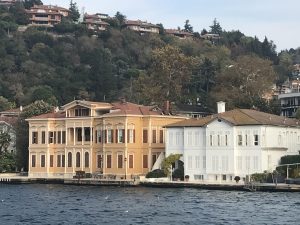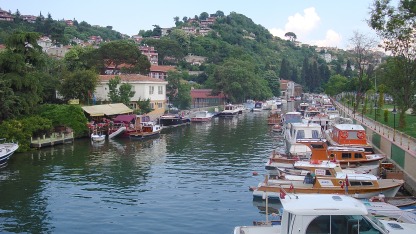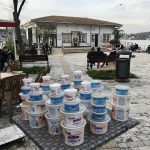“The Anatolian Castle”

Anadolu Hisarı is to the Asian side of İstanbul what Rumeli Hisarı is to the European side: namely, a suburb dominated by a castle built in the Middle Ages to control the approach to what was then Constantinople via the Bosphorus. This is a rather chi-chi suburb, a fact reflected in the excellent delicatessen facing the ferry terminal.
Around Anadolu Hisarı
The main reason to come for a visit is to take a closer look at the ruins of the castle although the modern coast road slices straight through what would once have been the middle of it. The original castle was the handiwork of Sultan Beyazıd I (1481-1512), great-grandfather of Sultan Mehmed the Conqueror who later reinforced it. Planning an assault on Constantinople, he selected a site for the castle that had once been occupied by a temple to Jupiter. Completed in 1394, Beyazıd’s castle had a central keep with a surrounding wall as well as an outer barbican with three towers that still stand today. From it the sultan launched an assault on Constantinople in 1395 which only came to an end in 1402 when the invasion of Timur the Lame (Tamurlane) resulted in his being carried off in chains to Ankara. It fell to his grandson, Mehmed II, to build a second castle on the opposite shore and thereby finally seize the city from the Byzantines.
In 2024 the castle opened to visitors (closed Mondays) after restoration. The views from the ramparts are superb, offering a bird’s eye view of the Göksu river and what was once the popular Sweet Waters of Asia picnic area.
In a garden behind the castle you’ll find a namazgah, an open-air prayer area probably dating back to the 18th century and still in use for Friday prayers in summer.
Beside the castle flows the Göksu river. Today the line-up of boats along its banks makes for a pretty sight but it’s still hard to imagine the days when it, together with the Küçüksu river further south, made up a pleasure ground called “the Sweet Waters of Asia” to which Turks would flock for picnics and other entertainments. In the 2020s work started to restore the meadow to that purpose with new plane trees planted and picnic benches supplied.
The shore at Anadolu Hisarı is still partially lined with yalıs, the fine wooden mansions that were once an even more impressive feature of the Bosphorus than they are today. This is where you’ll find the oldest surviving yalı, the Köprülü Amcazade Hüseyin Paşa Yalı, dating back to 1698 when it was built for the Grand Vizier Huseyin Paşa. Only its central section still survives sitting in the shadow of the Fatih Sultan Mehmet (FSM) Köprüsü, the Second Bosporus Bridge that was erected in 1988. It was in this yalı that the Treaty of Carlowitz that ended the Austro-Ottoman War of 1683-99 was thrashed out. Its disadvantageous terms are usually seen as marking the point at which Ottoman power started to slip into decline.
Unfortunately, despite its history the yalı has been behind wraps since before 2010, supposedly for restoration although there has never any sign of any work.
Almost next door is the lovely 19th-century Zarif Mustafa Paşa Yalı, once home to a strand of hair from the Prophet Mohammed’s beard which has since been donated to Fatih Cami. Like many of the yalıs, it has had a colourful history, having been used at one stage to store weapons that would be smuggled to the Turkish resistance in Anatolia in the aftermath of the First World War as well as having been hit by passing ships on two separate occasions. It now belongs to a member of the wealthy Sabancı family.
Also worth looking out for (and the yalıs are really better observed from the water than from land) is the Hekimbaşı Salih Efendi Yalı, named after the physician to the sultans who lived here in the mid 19th century. One of its most famous visitors was the British travel writer, Freya Stark. It’s still painted the traditional rusty red colour that was known as “Ottoman rose”. Unfortunately in 2018 diners at the adjacent restaurant were forced to watch in horror as an out-of-control tanker crashed into the yalı, reducing it to matchwood.
TEMA-Vehbi Koç Doğal Kültür Merkezi TEMA is an environmental organisation that has done a great job of reafforesting many parts of Turkey, and its centre on the hills above Anadolu Hisarı is home to many flowering plants. It’s long overdue for some maintenance but the Bosphorus views are spectacular.
 Eating
Eating
In the lee of the castle the Telgrafhane is a very colourful little cafe housed in what used to be the old telegraph office dating back to 1855.
Transport info
The limited but timetabled ferry service to Anadolu Hisarı (https://www.sehirhatlari.istanbul/) is certainly the nicest way to get to and from the suburb from Üsküdar in summer. There is also a very frequent ferry connecting Anadaolu Hisarı with Küçüksu and Aşiyan on the European shore. This then connects with the F4 funicular up to Boğaziçi Üniversitesi which in turn connects with the Metro to Taksim.
Otherwise you can pick up a bus in the 15 series from Üsküdar and trundle slowly along the coast road.
Nearby areas


